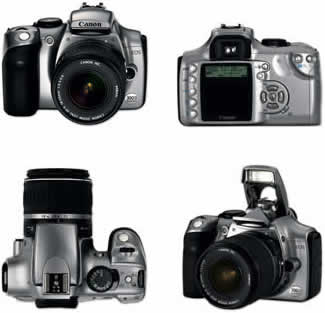Category: Digital SLR Cameras
DP-Now are reporting that the price of the Olympus E-1 at the UK’s largest photography chain, Jessops, has just been rather drastically reduced.
“Olympus had set the suggested retail price of the price of the E-1 body in the UK when it was formally launched on 24th June. That price was ?1699, including VAT, but without a lens.
The Jessops price is now ?1819 including VAT, complete with the 14-54mm (28-108 equivalent) standard zoom, just ?120 more than the original body-only price. The lens in question is definitely no budget cheapie…”
Website: DP-Now - Could the Olympus E-1 price be coming down?
UPDATE Tues 26 2003
DPReview have just published some US street prices for the E-1 body only and lenses, as supplied by Olympus USA. The E-1 will cost $1799 body only, the 14-54 mm F2.8 - F3.5 lens $499, the 50-200 mm F2.8 - F3.5 lens $999, the 50 mm Macro F2.0 lens $499, and the 300 mm F2.8 lens a whopping $6999.
Website: DPReview - Olympus E-1 US Pricing
DP-Now are reporting that the price of the Olympus E-1 at the UK’s largest photography chain, Jessops, has just been rather drastically reduced. “Olympus had set the suggested retail price of the price of the E-1 body in the UK when it was formally launched on 24th June. That price…
 Ian Burley at DP-Now.com has just posted an excellent First Look at the Canon EOS 300D, featuring 27 photographs from yesterday’s launch event in London. The 5th photo features a graph, not the most interesting subject you might think, but it shows Canon’s market forecast for DSLR’s:
Ian Burley at DP-Now.com has just posted an excellent First Look at the Canon EOS 300D, featuring 27 photographs from yesterday’s launch event in London. The 5th photo features a graph, not the most interesting subject you might think, but it shows Canon’s market forecast for DSLR’s:
“Canon sold 72,000 digital SLRs in Europe during the whole of 2002, but EOS-300D manufacturing for the worldwide market is already set at 70,000 units a month. By 2005 Canon expects to have at least a 50% market share of the DSLR market in Europe. That market will be 10x greater than 2002 in volume terms, predicts Canon.”
Scary stuff, especially for Nikon, Olympus and the other major players!
Website: DP-Now - Canon EOS-300D First Look
Ian has also updated his Canon EOS 300D report with links to some sample images taken with a pre-production camera, taken by Kai Thon, at the Norwegian site www.digit.no. The images show the ISO range of the 300D, with the same image taken at ISO 100, 200, 400, 600 and 1600.
Website: DP-Now - Canon EOS-300D Report
Ian Burley at DP-Now.com has just posted an excellent First Look at the Canon EOS 300D, featuring 27 photographs from yesterday’s launch event in London. The 5th photo features a graph, not the most interesting subject you might think, but it shows Canon’s market forecast for DSLR’s: “Canon sold 72,00…
 Canon have been extremely quick off the mark in releasing the 140 page Canon EOS 300D User Manual for download.
Canon have been extremely quick off the mark in releasing the 140 page Canon EOS 300D User Manual for download.
Website: Canon EOS 300D User Manual
The EOS 300D Kit will comprise the following items:
- EOS DIGITAL REBEL/EOS 300D DIGITAL camera body (with Eyecup, body cap and lithium backup battery for the date and time)
- EF-S18-55mm f/3.5-5.6 (with lens cap and dust cap) * In optional lens kit.
- Battery Pack BP-511 (includes protective cover)
- Battery Charger CB-5L
- Power cord for battery charger
- Interface Cable IFC-300PCU
- Video Cable VC-100
- Neck Strap EW-100DB ll (with eyepiece cover)
- EOS DIGITAL Solution Disk (CD-ROM)
- Adobe Photoshop Elements Disk (CD-ROM)
- Pocket Guide
- Quick guide to using the camera.
- EOS DIGITAL REBEL/EOS 300D DIGITAL Instructions
- Installing the Software Correctly - Explains the software installation and features.
- EOS DIGITAL REBEL/EOS 300D DIGITAL Software Instructions - Explains the procedure for transferring images to a personal computer and for RAW image processing.
- Battery Pack BP-511 Instructions
- Warranty card
- No CF card is included. Please purchase it separately. CF cards made by Canon are recommended.
Canon have been extremely quick off the mark in releasing the 140 page Canon EOS 300D User Manual for download. Website: Canon EOS 300D User Manual The EOS 300D Kit will comprise the following items: - EOS DIGITAL REBEL/EOS 300D DIGITAL camera body (with Eyecup, body cap and lithium backup…
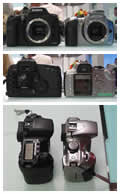 Rob Galbraith has posted a pretty thorough comparison of the main differences in functionality between the new Canon EOS 300D (known as the Rebel in the US) and the EOS 10D. If you’ve read and re-read all of the information from yesterday’s launch, and you’re still wondering what the similarities and differences between the 2 cameras are, then Rob’s site is a good place to start.
Rob Galbraith has posted a pretty thorough comparison of the main differences in functionality between the new Canon EOS 300D (known as the Rebel in the US) and the EOS 10D. If you’ve read and re-read all of the information from yesterday’s launch, and you’re still wondering what the similarities and differences between the 2 cameras are, then Rob’s site is a good place to start.
Here’s one major difference that might influence you towards the 10D:
“The Digital Rebel incorporates the same 7-point autofocus module as the 10D, and is promised to have the same overall autofocus performance too. There’s one significant difference, however: the Digital Rebel doesn’t allow for the selection of AF mode. While you can choose between manual focus and autofocus (by flipping the AF/M switch on any Canon EF lens), in the exposure modes of most use to serious shooters - Shutter Priority, Aperture Priority, Program and Manual - the Digital Rebel chooses between One Shot AF and AI Servo AF automatically on the fly, in a mode called AI Focus. If you’d prefer to choose one or the other yourself, then you’ll need a different camera.”
You can click the image above to view the Canon 300D and 10D side-by-side; as you can see, the 300D is noticeably smaller than its big brother. It would be interesting to see a similar comparison with the Pentax *ist D…
Website: Rob Galbraith
Rob Galbraith has posted a pretty thorough comparison of the main differences in functionality between the new Canon EOS 300D (known as the Rebel in the US) and the EOS 10D. If you’ve read and re-read all of the information from yesterday’s launch, and you’re still wondering what the similarities…
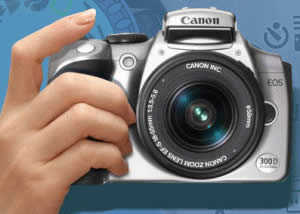 Canon have now officially announced the EOS 300D. There’s an official Canon Japan website up and running with all the details, including sample images:
Canon have now officially announced the EOS 300D. There’s an official Canon Japan website up and running with all the details, including sample images:
Website: Canon Japan
Features
Here is a brief summary of the main features:
- Effective pixels: Approx. 6.30 megapixels (3088x2056)
- Aspect ratio: 3:2
- 35mm-equivalent focal length is equal to approx.1.6 times the marked focal length
- Image format: JPEG and RAW (12-bit)
- White Balance Settings: Auto, daylight, shade, cloudy, tungsten bulb, White fluorescent light, flash, custom
- Color temperature compensation: White balance bracketing: +/-3 stops in whole-stop increments
- Auto Focus points: 7
- Focusing modes: One-Shot AF, AI Servo AF, AI Focus AF, Manual focusing (MF)
- Metering system: TTL full aperture metering with 35-zone SPC(1) Evaluative metering (linkable to any AF point)(2) Partial metering (approx. 9% of viewfinder at center)(3) Centerweighted average metering (Set automatically in manual exposure mode)
- ISO 100, 200, 400, 800, 1600
- Shutter speeds: 1/4000 - 30 sec. (1/3-stop increments), bulb, X-sync at 1/200 sec
- Drive modes: Single, continuous, Self-timer/Remote control
- Continuous shooting speed: Approx. 2.5 fps (at 1/250 sec. or faster speeds)
- Max. burst during continuous shooting: 4 shots
- PictBridge-compatible
- Weight: 560 g / 19.7 oz (body only)
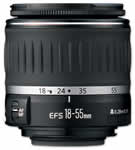 Lens
Lens
The 300D will ship as a body only option or with an EF-S 18-55mm f/3.5-5.6 lens (29-88mm equivalent) zoom lens. Canon have also announced a 55-200mm (88-320mm equivalent) f/4-5.6 telephoto zoom.
Pricing
The Canon EOS 300D will retail for approximately Euro 1179 / ?899.99 for the body only, and Euro 1279 / ?999.99 complete with the 18-55mm (29-88mm equivalent) zoom lens. All prices include VAT.
Other websites that also have the news:
Website: DP-Now
Canon have now officially announced the EOS 300D. There’s an official Canon Japan website up and running with all the details, including sample images: Website: Canon Japan Features Here is a brief summary of the main features: - Effective pixels: Approx. 6.30 megapixels (3088x2056) - Aspect ratio: 3:2 - 35mm-equivalent…
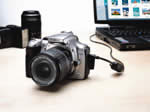 Here is the full un-edited Canon EOS 300D Press Release from Canon Europe:
Here is the full un-edited Canon EOS 300D Press Release from Canon Europe:
Amstelveen, The Netherlands, August 20, 2003. - Canon, a leader in photographic and imaging technology, today launches the EOS 300D 6.3 Megapixel digital SLR. The availability in the market of an affordable consumer digital SLR is expected to greatly accelerate the speed of adoption by consumers.
?Canon expects 400-500% growth in the digital SLR segment from 2002 to 2003 in terms of shipping volume[1],? says Hiroshi Komatsuzaki, Head of Canon Consumer Imaging Europe. ?The EOS 300D will play a key strategic role in this growth. By dropping the price so significantly, Canon is very deliberately putting high performance EOS digital technology into the hands of the consumer at a time of accelerating demand for high performance digital cameras?.
The EOS 300D bundles proven high performance technologies (such as seven-point, high-speed predictive auto focus, 2.5 frame per second burst rate, 35-zone metering and DIGIC image processor) into a camera affordable to everybody.
Canon has declared the EOS 300D to be the single most important consumer SLR since the AE-1 in 1976. Just as the AE-1 triggered an SLR revolution by being the world?s first camera with an embedded microcomputer, Canon believes the EOS 300D will be seen as the point in history when the SLR market shifted irrevocably to digital.
 Precision optics, unrivalled sensor quality
Precision optics, unrivalled sensor quality
At the front end of the EOS 300D is the lens system and digital sensor. Film EOS users considering the move to digital will be pleased to learn the EOS 300D works seamlessly with any of Canon?s renowned EF lenses, of which there are currently more than 60.
An APS-C sized sensor gives the camera a 1.6x magnification over 35mm film format. In order to furnish EOS 300D customers with the equivalent 28-90mm zoom range so popular with 35mm film EOS users, a new EF-S 18-55 f/3.5-5.6 lens [2] has been specially developed. This lens takes advantage of the compact sensor size, employing a ?short back focus system? which mounts the lens closer to the sensor than previous models. This provides high-quality images in a remarkably low-weight, short-length lens.
The 6.3 Megapixel CMOS sensor is almost identical to that found in the award-winning EOS 10D which remains the benchmark for image quality. ISO speeds of 100, 200, 400, 800 and 1600 are selectable, giving film users a film speed range with which they will be comfortable.
Print straight from the camera
The EOS 300D is the first digital EOS camera to support the vendor-independant PictBridge print standard from launch date. Lab-quality prints can now be produced without the need for a computer by directly connecting the EOS 300D to compatible photo printers via standard USB cable. A large 1.8? LCD is used to select and review photographs to be printed and set print variables.
Fast image processing with superb results
Underpinning the camera?s technical superiority is Canon?s high-speed DIGIC (Digital Image Core) processor. In the days of film, image processing was the role of film companies and mini-labs. With digital, the critical role of image processing must be handled by the camera. Complex algorithms required to accurately process functions such as white balance and color rendition are integrated into the DIGIC processor, resulting in highquality images with no trade-off in camera responsiveness. ?A great digital image requires both quality raw ingredients and quality processing? says Komatsuzaki. ?Superior lens and sensor technologies ensure the best raw ingredients. It is what DIGIC does with these that gives the EOS 300D the edge?.
Wide area, high speed focusing
7 selectable focusing points give an ultra wide AF area generally only found in advanced SLRs. Focusing modes include One-Shot AF (for fast, accurate single-shot focusing), and AI AF which can automatically switch to AI servo AF for continuous tracking of subject movement ? well suited to sports photography. A Manual Focus override is selectable from the lens.
High-end exposure control
The EOS 300D boasts 35 zone TTL metering, essentially covering the full frame. Three metering modes (evaluative, partial, and centre weighted average) assure balanced exposures in every situation. Along with the full range of automated and manual shooting modes expected in a high-end SLR, the EOS 300D features Programmed Image Control modes such as Night Portrait, Sports, Close-up, Landscape, Portrait and Flash OFF. A built-in automatic flash pops up nearly 90mm above the optical axis to lessen the chance of red-eye for better flash photos.
Shooting adaptability
The EOS 300D is superbly specified to deliver outstanding results in virtually any shooting situation. The camera has a shutter speed range of 1/4000 ? 30 seconds, bulb and high speed x-sync at 1/200s. Simultaneous recording to both RAW and JPEG (middle/fine) formats is possible, while 2GB and higher CompactFlash cards, Types I and II, are supported. Optional wired or infra-red wireless remote control is available. Adobe RGB has been added to the standard sRGB colour space. There are seven Auto White Balance settings (such as cloudy, tungsten, fluorescent, etc.) plus custom White Balance and +/- 3 stop White Balance Bracketing (WB-BKT).
Comprehensive accessories, software and online access
The EOS 300D comes complete with battery pack, charger, USB cable, video cable, wide embroidered anti-slip neck strap. Purchase of the EOS 300D entitles customers to membership of the CANON iMAGE GATEWAY [3] web portal for a 100 MB online photo album for image uploads. A full software suite is included for handling image file transfers between camera and computer, managing and printing files, and preview and conversion of RAW image files. PhotoStitch is included for seamless merging of panorama shots.
Mr. Mitarai?s (President and CEO of Canon Inc.) announcement can be viewed after 14:00 CET on August 20th at the following link: http://www.canon.com/press_movies/speech0802.asx
[1] Source: JEITA data with Canon forecast
[2] The lens will not be sold separately and will only be available with the purchase of the EOS 300D
[3] May not be available in all regions
Here is the full un-edited Canon EOS 300D Press Release from Canon Europe: Amstelveen, The Netherlands, August 20, 2003. - Canon, a leader in photographic and imaging technology, today launches the EOS 300D 6.3 Megapixel digital SLR. The availability in the market of an affordable consumer digital SLR is expected…
 Here is the full un-edited Canon EF-S 18-55mm Lens Press Release from Canon Europe:
Here is the full un-edited Canon EF-S 18-55mm Lens Press Release from Canon Europe:
Amstelveen, The Netherlands, August 20, 2003 - Canon, a leader in photographic and imaging technology, today releases the EF-S 18-55mm f/3.5-5.6 zoom lens, designed to work exclusively with the new EOS 300D, also released today. The lens will not be sold separately and will only be available when purchased together with the EOS 300D.
The EOS 300D features an APS-C sized sensor, which gives the focal length of the lens a 1.6x magnification effect over 35mm film format. Canon’s goal is to furnish EOS 300D customers with the equivalent 28-90mm zoom range so popular with 35mm film EOS users. The new lens was therefore given a focal length of 18-55mm, which is equivalent to 29-88mm in the 35mm film format.
The more compact sensor size of the EOS 300D means the camera’s reflex mirror can also be smaller, making it possible to bring the back of the lens closer to the image sensor. The ‘S’ in the EF-S nomenclature stands for ‘short back focus’, which describes this new system. Manufacturing costs associated with such a wide-angle zoom lens would normally be very high. The ‘short back focus’ system of the EOS 300D, however, has allowed Canon’s design engineers to develop a remarkably low-weight, short-length lens that retains all the high-quality hallmarks of the EF range. The result is an opportunity for EOS 300D users to work with a lens that would normally carry a prohibitively expensive price tag.
Perfect for digital
By optimising the EF-S 18-55mm f/3.5-5.6 lens coatings, Canon’s engineers have effectively minimised the chance of flare and ghosting which are more prone to occur with digital cameras than with film cameras. The coatings reduce reflections off the rear of the lens to deliver crisp, undistorted digital images.
Fast and close auto-focus
The drive pattern of the lens has been tailored to specifically match that of the EOS 300D, for quiet, precise and fast auto focus. A minimum focusing distance of just 0.28m is available at all focal lengths through the zoom range.
Appealing background blur
The lens incorporates an EMD (electromagnetic diaphragm), which in the widest apertures employs an almost perfectly circular barrel aperture. This provides the best blur effect in situations where the photographer is deliberately working with a small depth of field to isolate the subject.
New mount
While the EOS 300D is compatible with the more than 60 EF lenses, the EF-S 18-55mm f/3.5-5.6 has a new mount in the EF lens series which fits only the EOS 300D. A white lens mount index (in addition to the traditional red marking) differentiates the lens from other EF lenses and a rear rubber ring prevents any damage in the event that an inadvertent attempt is made to mount the EF-S lens on a camera other than the EOS 300D.
In harmony with the environment
In keeping with Canon’s stringent environmental policy, only lead free glass is used in the lens’ optics.
New accessories
Because of the new mount, two new extension tubes have been developed for Canon’s EF lens range, the Extension Tube EF12II and EF25II. These new tubes replace the Extension Tubes EF12 and EF25 and, as with these superceded tubes, work with almost every available Canon EF lens. Their new mount allows them to also work with the new EF-S 18?55mm f/3.5-5.6.
Phenomenal magnification
Extension tubes are close-up accessories placed between the camera body and the lens to enable high-magnification photography. Through eight electronic contact points, electronic function is the same as during normal photography for compatible lenses. Magnification differs according to the lens, but for standard zoom lenses it is about 0.3 to 0.5 for the Extension Tube EF12II and 0.7 or over for the Extension Tube EF25II.
Mounting and data transfer
Both extension tubes have a white lens mount index (in addition to the traditional red marking) to indicate compatibility with the new EF-S lens. When mounted between an EOS camera and an EF lens, standard EOS-dedicated information is transferred seamlessly between camera body and lens. This includes lens status, lens type, metering information, focal length and AF drive information.
Here is the full un-edited Canon EF-S 18-55mm Lens Press Release from Canon Europe: Amstelveen, The Netherlands, August 20, 2003 - Canon, a leader in photographic and imaging technology, today releases the EF-S 18-55mm f/3.5-5.6 zoom lens, designed to work exclusively with the new EOS 300D, also released today. The…
In this interview, given just days before the launch of the EOS 300D, Alessandro Stanzani talks about the EOS 300D, its role in changing the face of photography and Canon?s passion for the SLR.
Why is Canon suddenly placing so much emphasis on SLRs?
SLR is Canon?s heritage. EOS is our heart; SLR is our story. We are number one in SLRs around the world. In Europe we have a 40% share of the SLR market. And the future of SLR is digital. As leader, our mission is to be at the vanguard of the global shift to digital. Already most major news agencies are specifying the professional series EOS 1D for their photographers. The EOS 300D is the best proof Canon can give to the market that the age of digital SLR has arrived.
What is so important about the EOS 300D?
Canon is also the world leader in photography. The EOS 300D carries this leadership forward by making available, for the very first time, high-end digital SLR technology at an affordable price. History will remember the launch of the EOS 300D as the point in time when the imaging market shifted irrevocably from analogue to digital.
What are Canon?s expectations for digital SLR growth?
Canon anticipates the market for digital SLRs to grow between 400% and 500% in 2003, over 2002. This market will increase 10 times from 2002 to 2005. Canon expects to have a 50% share of this market.
Canon has said this is the most significant camera since the AE1. How so?
The AE-1 was the world?s first camera with an embedded microcomputer. But what did that mean? There were other cameras available at the time capable of doing what the AE-1 could do. The critical point of this development was that it allowed for the production of a low-cost camera with high-end features. This sparked an SLR revolution. There are hundreds of thousands of people across Europe waiting for an affordable digital SLR. Either they are using film SLR, or they understand the benefits of SLR photography. Maybe they remember the AE1. Until today their only chance of digital SLR ownership has been to purchase a professional or semi-professional camera, which for most people is simply not affordable. The EOS 300D changes all that. It will spark enormous growth, opening up the market not only to keen amateur photographers, but to the masses. The EOS 300D is about to trigger the next SLR revolution.
Why has Canon waited until now to declare that this is the time to convert to digital?
Photography used to be tightly limited. Shoot a roll of film, take it to the photo store and pick up the prints some time later. For 99% of people, this is what photography was. Only professionals and dedicated enthusiasts had the time and resources to truly explore their creativity.
Now we are witnessing a convergence of services, products and technologies that is putting choice and creativity into the hands of consumers. It is not just about digital cameras now having the quality to compete with film. Consumers can produce lab-quality prints at home by connecting their camera directly to affordable, high quality photo-printers. They can use web services ? such as our CiG web portal for Canon customers ? to store and share albums and make online orders for home-delivered prints. And as for dropping off rolls of film to the lab, photographs to be printed can now be left on flash cards or Microdrives and dropped off to an ever-expanding base of digital print retailers.
Alongside that, we are witnessing a huge shift in consumer behaviour. Consumers with digital cameras are taking five times as many photographs as they used to. They are experimenting with software to edit, manipulate and enhance their photographs. They are expressing their imagination. So the digital world is removing the limits to creativity by opening up entirely new possibilities.
The final ingredient in the mix is camera affordability. Sales of digital compacts show they are already at a realistic price point. The EOS 300D price now brings digital SLR into the picture.
Why has Canon chosen to stick with the CMOS sensor?
The Canon CMOS sensor is a complete Canon development and considerable R&D resource has been invested into perfecting it. Awards won by our current product line-up would suggest our efforts have been well directed. Given that it now represents the current image quality benchmark against which other sensors are compared, it makes good sense for us to have chosen CMOS.
Is Canon committed to sticking with CMOS ahead of CCD technology?
Canon?s approach has always been to select the most appropriate technology for the product under consideration. In the case of the EOS 300D, CMOS was chosen simply because it is the most suitable sensor technology to enable us to introduce consumers to digital SLR photography.
What is the difference between the CMOS sensor found in the EOS 10D and the EOS 300D?
The CMOS sensor found in the EOS 300D is similar to that found in the EOS 10D. The manufacturing process is slightly different, but the quality output between the two devices is essentially the same. The three-layer optical low pass filter and IR cut filter are identical to those found on the EOS 10D, where they have proven highly effective.
Why does the EOS 300D have an APS-C sensor instead of full frame?
The APS-C sensor has some advantages, which made it the obvious choice for the EOS 300D. The key has been the possibility to bring professional quality digital SLR photography to the consumer price point of the EOS 300D.
Does Canon have a full-frame consumer digital SLR in the wings?
No. The EOS 1Ds has a 35mm sensor but this is a camera which suits the highly specialised requirements of a very select group of professional photographers. The strategy for Canon is to design cameras to suit our customer?s needs. So what does full frame really mean? With 6.3 million pixels, the EOS 300D sensor has a resolution which, in most situations, would meet the needs of many professional photographers. At the same time, this sensor size has allowed us to meet our design objective of putting high-end technology into the hands of the consumer. From a technical perspective, putting a 35mm sensor into the EOS 300D would, in most cases, give no advantage to our customers. Yet in doing so we would force the price well out of our target range.
Is the EF-S lens the start of a new EF-S series?
The short back focus system of the EOS 300D provided a route for Canon to develop the EF?S 18?55mm - a high performance, low weight, short length, cost effective standard zoom lens for EOS 300D customers. This lens only fits the EOS 300D but, as with all EOS cameras, the EOS 300D fits every lens in the EF range. So when the time comes for EOS 300D customers to consider their next lens, they will share the advantage of every other EOS user by having the whole range of over 60 EF lenses to choose from. This particular EF-S lens is therefore seen as a specialised lens within the EF range. It is the EF range to which we are committed and to which Canon continues to invest substantial development resource.
Canon has recently made a lot of noise about the success of DIGIC. Is the DIGIC processor in the EOS 300D the same as that found in other Canon cameras?
Yes, it is the same chip. The DIGIC processor has a number of functional blocks within it. Different functional blocks are used, depending on what type of camera we are dealing with. For example, the focusing systems between compact cameras and SLRs are fundamentally different. If you look at the digital SLR body, it has a sensor dedicated for focus, a sensor dedicated to exposure metering and then the image sensor, all on different optical paths. A digital compact camera has all those three functions integrated into the main imaging sensor. So given the integral role DIGIC plays in the camera?s image processing, it stands to reason that the way in which DIGIC is used will depend largely on what type of camera is employed.
The market seems intent on using pixel count as a means of measuring a camera?s worth. Is having the highest number of pixels important to Canon?
Pixel count is of course crucial to Canon; it is the parameter on which many users first focus when comparing models. But as numerous specialised and reliable magazines have proved, it is just one of many factors influencing image quality. Lens quality is obviously critical and image processing functions play a crucial role ? hence Canon?s massive investment in lens technologies and DIGIC processors.
Winning the pixel race can have very little to do with building quality cameras that return exceptional images, and customers are beginning to understand this.
What does Canon see as the competition to the EOS 300D?
There is no directly competing digital SLR at this price point for consumers. Competitors for the EOS 300D therefore come from outside its field, either in terms of price or performance. In terms of performance, the EOS 300D is up against digital SLRs that are currently more than twice its price. In terms of price, the EOS 300D offers potential purchasers of digital compact cameras a choice; either digital SLR or advanced digital compact camera.
In an interview you gave in February you predicted that sales of digital still cameras would double this year. How has the market performed against that prediction?
The market continues to be ahead of that projection. Canon expects that the introduction of the EOS 300D will trigger 500% growth in the digital SLR market in 2003, over 2002. The research we now have shows that across the whole array of consumer products, digital cameras are one of the three most desirable products; the other two being DVD players and new generation mobile phones.
In that same interview you predicted that unit sales of digital cameras will outstrip that of analogue. Has that yet happened?
Yes. Shipment of digital cameras has already over-taken that of analogue; in fact this happened at the beginning of 2003. In terms of market value, digital overtook analogue two years ago. The world-wide install base of digital cameras was predicted to overtake that of analogues by 2010 but we now expect this to happen earlier.
Will Canon continue to develop analogue SLR products?
Yes. There will continue to be demand for analogue SLRs and we will continue to develop products to meet that demand. This is clearly the turning point where the market will make a significant shift to digital, but we recognise there is enormous value in continuing to support the analogue market.
A complaint of Canon digital cameras is that Canon is often unable to keep supply up to meet demand. How does Canon intend to meet anticipated demand for the EOS 300D?
Once the market is aware, there is no doubt there will be enormous demand for the EOS 300D, and we have stocked accordingly. What Canon wants to do is shorten the time between availability and market awareness. Waiting for reviews, articles and information to be published can take two or three months. But we want everybody to know right now that this is the product, and this is the price. This is why there is so much focus on the launch.
Olympus has proposed a common lens mount. Does Canon have any plans to join the program?
The Kodak and the Olympus lens mount is a completely new and largely unproven development and as yet there are very few lenses which work with this system. With over 60 proven lenses available to our EOS customers in the EF lens line up, we have no plan to join the common lens mount proposed by Olympus.
In this interview, given just days before the launch of the EOS 300D, Alessandro Stanzani talks about the EOS 300D, its role in changing the face of photography and Canon?s passion for the SLR. Why is Canon suddenly placing so much emphasis on SLRs? SLR is Canon?s heritage. EOS is…
 Fuji have released a new version of software for the Fuji FinePix S2 Pro DSLR. It includes camera shooting software compatible with the Macintosh OS X operating system, a new EXIF Extractor and updated versions of the RAW File converter LE, RAW File Converter EX Version 2.0 and Camera Shooting Software Version 2.0.
Fuji have released a new version of software for the Fuji FinePix S2 Pro DSLR. It includes camera shooting software compatible with the Macintosh OS X operating system, a new EXIF Extractor and updated versions of the RAW File converter LE, RAW File Converter EX Version 2.0 and Camera Shooting Software Version 2.0.
At the same time, Fujifilm USA have also announced a price reduction for the FinePix S2 Pro, which is now available at a suggested price of $2295.
Website: BytePhoto - FinePix S2 Pro Software Update
Website: FinePix S2 Pro Software Download
Fuji have released a new version of software for the Fuji FinePix S2 Pro DSLR. It includes camera shooting software compatible with the Macintosh OS X operating system, a new EXIF Extractor and updated versions of the RAW File converter LE, RAW File Converter EX Version 2.0 and Camera Shooting…
_thumb.jpg) Pentax Japan have posted 3 sample images taken with their new DSLR, the Pentax *ist D. There’s 1 image each taken with the 200mm, 100mm macro and 18-35mm lenses.
Pentax Japan have posted 3 sample images taken with their new DSLR, the Pentax *ist D. There’s 1 image each taken with the 200mm, 100mm macro and 18-35mm lenses.
Website: Pentax Japan
Pentax Japan have posted 3 sample images taken with their new DSLR, the Pentax *ist D. There’s 1 image each taken with the 200mm, 100mm macro and 18-35mm lenses. Website: Pentax Japan
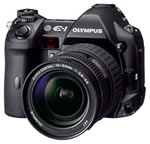 DPReview have now got a production version of the Olympus E-1 in for review. Yesterday they updated their E-1 Preview, posted 18 sample images and compared the E-1’s noise levels against other competitors’ DSLRs.
DPReview have now got a production version of the Olympus E-1 in for review. Yesterday they updated their E-1 Preview, posted 18 sample images and compared the E-1’s noise levels against other competitors’ DSLRs.
“Up to ISO 800 noise levels from the E-1, EOS-10D and D100 are relatively similar. Of these three the EOS-10D has the cleanest images at ISO 100 and 200 followed by the D100 and then the E-1. At ISO 1600 the E-1’s noise levels leap notably (and visibly) higher than the EOS-10D and D100 which both maintain similar levels. Throughout the ISO range Fujifilm’s impressive S2 Pro plots a shallow noise curve none of the other cameras can match.”
Website: DP Review - Olympus E-1 Sample Photos
Website: DP Review - Olympus E-1 Preview (updated)
Website: DP Review - Olympus E-1 vs Canon 10D vs Nikon D100 vs Fujifilm S2 Pro Noise Comparison
DPReview have now got a production version of the Olympus E-1 in for review. Yesterday they updated their E-1 Preview, posted 18 sample images and compared the E-1’s noise levels against other competitors’ DSLRs. “Up to ISO 800 noise levels from the E-1, EOS-10D and D100 are relatively similar. Of…
_thumb.jpg) I’d almost forgotten about Pentax’s new DSLR, the *ist D, which back in May was officially delayed until the end of August due to “a delay in the procurement of material required”.
I’d almost forgotten about Pentax’s new DSLR, the *ist D, which back in May was officially delayed until the end of August due to “a delay in the procurement of material required”.
It now seems that Pentax have procured whatever it was that they needed, as this morning they have officially announced that the *ist D will begin shipping in September. So all you Pentax owners out there can now breathe a big sigh of relief!
Here’s an excerpt from the US press release:
“PENTAX U.S.A., Inc. announced that the long anticipated digital SLR *ist D camera (pronounced ist-dee) will begin shipping in September 2003* to the United States.
Housed in one of the world?s smallest, lightest SLR camera bodies, the *ist D comes equipped with an array of advanced functions and user-friendly features, including an APS-sized CCD with impressive 6.1 effective megapixels, a responsive SAFOX VIII autofocus system with 11-point AF sensor, a sophisticated 16-segment multi-pattern metering system, a bright viewfinder with a newly developed compact glass pentaprism, an innovative ?Hyper? operating system and 22 user-adjustable custom functions. The *ist D is compatible with existing PENTAX 35mm-format interchangeable lenses and accessories.*
* Some restrictions and conditions may apply to certain lenses and accessories.”
Pentax are also releasing 2 new lenses at the same time as the *ist D:
- smc PENTAX-FA J Zoom 18mm-35mm F4-F5.6 AL
- smc PENTAX-DA Zoom 16mm-45mm F4 ED AL
The DA part of the 16mm-45mm is very important. Pentax have also announced that they are developing a new DA Series of interchangeable lenses for the *ist D, with the smc PENTAX-DA Zoom 16mm-45mm F4 ED AL being the first ever lens in the DA series. The image circle in the DA-series lenses is designed to perfectly match the size of the CCD (23.5mm x 15.7mm) incorporated in Pentax’s digital SLRs, optimizing the performance of these cameras. The new design also contributes to a drastic reduction in size, weight and production cost, compared to 35mm-format counterparts with similar specifications.
No prices have yet been announced for either the *ist D body or the new lenses.
UPDATE: Luminous Landscape is reporting that the *ist D body will cost $1699 in the USA, or $1899 with the 18-35mm zoom lens (which seems like an excellent deal to me).
Website: Luminous Landscape
Several websites already have the news and the usual first looks and previews:
Website: BytePhoto
Website: DCResource
Website: DP-Now
Website: DPReview - Pentax *ist Preview
Website: Imaging Resource
Website: Steve’s Digicams
I’d almost forgotten about Pentax’s new DSLR, the *ist D, which back in May was officially delayed until the end of August due to “a delay in the procurement of material required”. It now seems that Pentax have procured whatever it was that they needed, as this morning they have…
According to Peter Sills of digitalfocus.net, Canon will announce an updated version of its EOS 1D digital SLR at the end of August.
“Canon will shortly announce a new camera, called of all things the 1Dx. According to our own sources, this new camera will be a refresh of the venerable 1D and will feature an improved 8 mpixel sensor, but the same FOV crop as the 1D. Framerate will remain unchanged as the camera gains double the number of megapixels.
Expected announcement is end of August - early September.”
Website: DPReview - Canon SLR Forum
According to Peter Sills of digitalfocus.net, Canon will announce an updated version of its EOS 1D digital SLR at the end of August. “Canon will shortly announce a new camera, called of all things the 1Dx. According to our own sources, this new camera will be a refresh of the…
The website Photography at About has published an interesting 5 part article which looks at the major new digital SLRs of 2003, the Pentax *ist D, Nikon D2H, Canon 10D and Olympus E1. If you’re currently trying to decide whether to make the leap to a digital SLR and which particular model you should buy, then this article provides a good overview of the current market.
“Although there seem to be several announcements of new digital cameras most weeks, few of these are of much interest to professional photographers. Progress in developing usable professional cameras often seems to be very slow. Pentax had a 6Mp ‘full-frame’ digital SLR in 2001, and some preliminary reviews based on prototypes appeared at the time, but we are still waiting to see an actual product.”
The website Photography at About has published an interesting 5 part article which looks at the major new digital SLRs of 2003, the Pentax *ist D, Nikon D2H, Canon 10D and Olympus E1. If you’re currently trying to decide whether to make the leap to a digital SLR and which…
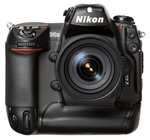 One story is dominating the headlines in the photography world today. Nikon have confirmed what many people already knew (as it was leaked on several websites last week) by announcing their new DSLR, the Nikon D2H, along with a bunch of new lenses and flashgun. Aimed at the professional sports and press photographer, the D2H body-only has a suggested RRP of ?2,800.
One story is dominating the headlines in the photography world today. Nikon have confirmed what many people already knew (as it was leaked on several websites last week) by announcing their new DSLR, the Nikon D2H, along with a bunch of new lenses and flashgun. Aimed at the professional sports and press photographer, the D2H body-only has a suggested RRP of ?2,800.
There are a number of websites that have posted extensive in-depth looks at the new camera. Ian over at DP-Now.com was one of the first to post the news and his preview is well worth checking out.
Website: DP-Now - Nikon D2H News
LetsGoDigital have had the opportunity to actually use the camera; they’ve posted an impressive presentation, although you will need to have the flash plug-in installed to view it.
Website: LetsGoDigital - Nikon D2H First Look
And as usual the ever-dependable DPReview have got the scoop, posting a 5-page preview of the camera.
Website: DPReview - Nikon D2H Preview
One story is dominating the headlines in the photography world today. Nikon have confirmed what many people already knew (as it was leaked on several websites last week) by announcing their new DSLR, the Nikon D2H, along with a bunch of new lenses and flashgun. Aimed at the professional sports…
It seems that the rumours of a new DSLR from Nikon are gaining ground. First reported by the French photographic magazine Chasseur d’Images a few days ago, Michael Reichmann is also adding his weight, going as far as identifying the D2’s main features:
- 4 Megapixel sensor
- 8 frames / sec
- approximately a 21 frame buffer in RAW mode
- minimum 125 ISO
- 802/11b wireless LAN
Website: Luminous Landscape - News
Website: Chasseur d’Images - Nikon D2H
It seems that the rumours of a new DSLR from Nikon are gaining ground. First reported by the French photographic magazine Chasseur d’Images a few days ago, Michael Reichmann is also adding his weight, going as far as identifying the D2’s main features: - 4 Megapixel sensor - 8 frames…
The French photographic magazine Chasseur d’Images are reporting that Nikon will release the D2 digital SLR on 22nd July. Apparently it will be a 4 megapixel model aimed at the professional photography, with speed rather than megapixels being the main selling point. The page is in French so you will need to translate it; Google does this quite nicely - here’s a translated quote:
“But it is on next 22 July which the new numerical reflex camera professional Nikon will take really its take-off since it is on this date that famous “the D2 will be revealed” about which one speaks on all the forums since months.”
Website: Chasseur d’Images - Nikon D2H
The French photographic magazine Chasseur d’Images are reporting that Nikon will release the D2 digital SLR on 22nd July. Apparently it will be a 4 megapixel model aimed at the professional photography, with speed rather than megapixels being the main selling point. The page is in French so you will…
I thought it would be interesting to take a snapshot of the Olympus discussion forum over at DPReview, just to see if there are any patterns emerging in people’s initial reactions to the new E-1. Here are the first 20 topic titles from 10:43am GMT:
Are Oly EXPECTING to sell that many E1’s?
E-1, My thoughts.
E1 : electronic lens shading and distortion correction
You guys sound like the Canon guys who
What an outcry!!
E-1 too littel, too late, too expensive
Fabulous Start - this sounds like a great camera
E1 - what’s your vote?
Missed My Chance to Post on Nikon Forum
I am impressed with the new E1 !
Three great reasons to buy an E1
E1 - Way Too Expensive
Comical Ali now works for Oly marketing….
Pricing is a two-edged sword
Bye Bye Olympus
E-1 - 13 reasons why its better than the 10D
E1? Active LCD viewscreen while shooting?
No build-in flash…..........!
Who are the pro’s?
Stop the insanity! (img)
Website: DPReview - Olympus SLR Forum
I thought it would be interesting to take a snapshot of the Olympus discussion forum over at DPReview, just to see if there are any patterns emerging in people’s initial reactions to the new E-1. Here are the first 20 topic titles from 10:43am GMT: Are Oly EXPECTING to sell…
 Several photography websites have followed up yesterday’s announcement of the Olympus E-1 with detailed First Looks at pre-productions cameras. Olympus have requested that no sample images are to be posted until a production version of the camera is released, which according to a lot of sites will be sometime in August.
Several photography websites have followed up yesterday’s announcement of the Olympus E-1 with detailed First Looks at pre-productions cameras. Olympus have requested that no sample images are to be posted until a production version of the camera is released, which according to a lot of sites will be sometime in August.
Here’s an initial reaction from Phil Askey of DPReview:
“So far I think the E-1 is an exciting, capable and well featured digital SLR. My primary concern at the moment is price, with an MSRP of $2199 for the body and $599 for the most useful lens (14 - 54 mm) you’re talking a street price of between $2200 and $2800 for a starter kit*, and that’s without a flash. There is no doubting the build quality and finish of the camera. The environment proofing (rubber seals etc.) are impressive as is the magnesium alloy body. Image quality is of course the one thing at this stage on which we can not comment but I am sure many people will be expecting the E-1 to be at least as good as the current crop of six megapixel digital SLR’s.”
Website: DCResource
Website: DP Review
Website: Imaging Resource
Website: Steve’s Digicams
Several photography websites have followed up yesterday’s announcement of the Olympus E-1 with detailed First Looks at pre-productions cameras. Olympus have requested that no sample images are to be posted until a production version of the camera is released, which according to a lot of sites will be sometime in…

